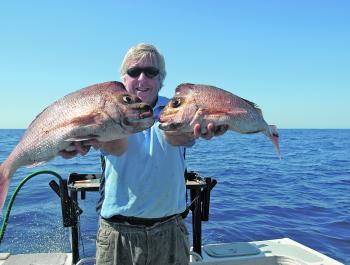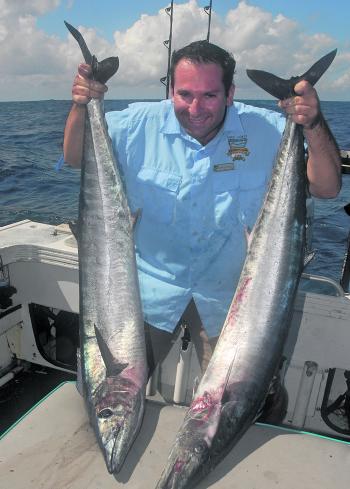May is a very productive month to fish the offshore grounds east of the Gold Coast. As the water temperature starts to drop there is a transition between summer and winter species. The current decreases on the 36 and 50 fathom reefs, which also makes bottom fishing much more productive.
Out wider, on the continental shelf, there should be some great blue marlin fishing this month. The season for these big fish has been erratic this year, with good days followed by long periods without a bite. In May the East Australian Current drops down in speed, and big offshore eddies form. If you look at the sea surface temperature graphs prior to heading offshore you can pick up the rough GPS coordinates of where the temperature breaks and current eddies are located. This information helps to plan your trips safely and more effectively. A massive blue estimated at 1100lb was caught and released recently by Lorraine Golightly onboard Merlen, skippered by legendary marlin skipper Bob Jones. This was probably the biggest fish ever caught off the Gold Coast.
In May quite a few monster blues over 200kg turn up in the slightly cooler water. This season quite a few blue marlin have been caught in relatively shallow water in the band between 90 and 150m. This area is only a few miles east of the 50 fathom reef.
In closer to shore there should be mackerel and wahoo. This season the most successful method to catch mackerel has been trolling live baits and rigged dead baits from a downrigger. This has worked well on the 24 fathom and 18 fathom reefs and is a deadly method that has out-fished every other technique most days. Spinning with metal lures is also a good easy method to try when the fish are deep. For wahoo, the Tweed Nine Mile is generally the best place to try. Troll minnows, high speed Hex Heads and live tuna to produce some good results. If the current is running across the reef and there are showering bait, there will generally be a few wahoo about. In the past, this area produced a lot of big mackerel tuna, but over the past few seasons they have greatly reduced in numbers.
Snapper fishing will pick up this month as the water cools. While it is still a few months before they spawn, a lot of fish start to move into the 36, 42 and 50 fathom reefs in the cooler conditions and can be caught on metal ‘slow’ jigs, floating baits and soft plastics. This will also produce pearl perch, parrotfish, teraglin and a few amberjack and yellowtail kingfish. These reefs fish quite well through May as they have had very little fishing pressure in the preceding months with currents making fishing difficult.
Mulloway and cobia will increase in numbers on the inshore grounds, and live baiting with tailor, big live slimy mackerel and yellowtail all work well. Berley makes a big difference when targeting cobia. Every season quite a few cobia over 30kg are caught in May on the reefs close to Southport.
As the first winter westerlies start to blow and the water cools, a lot of fish start to move towards the entrances of Jumpinpin and the Seaway in preparation for spawning. Mullet start to school up in numbers and this attracts a wide range of predators. Mulloway and yellowtail kingfish are good targets in the Seaway this month. In daylight hours the most successful bait is live pike. Catching pike is generally pretty easy. Work small hardbodies and soft plastics around the edges of weed beds on a run-in tide in clean water. While pike are not overly active bait, they are very effective on mulloway and kingfish.
When targeting mulloway in the Seaway in the day, use a ball sinker about 40cm above your bait and fish the edges of the rock walls, the hole at the end of the north wall of the Seaway and the down current side of the pipeline. Rig your pike on two hooks. I like 7/0 octopus patterns. For kingies drift your live pike through the Seaway channel and work around the marker buoys. The yellow marker off the end of the north wall of Wavebreak Island is a good spot to find a kingie. Some of these are quite big fish, the best I’ve seen caught from my boat a few years back weighed 17kg.
Flathead fishing greatly improves this month, and the fish are active and aggressive. There are often quite big schools of white pilchards in the estuary in May and when these are around the flathead will chase a lure all the way to the boat. Soft vibes, blades and soft plastics are all effective, and trolling with hardbodies is a reliable go-to method. The water is generally quite clear and it is a good time to chase flatties, with most fish between 40-60cm at this time of year.
This season has been good for whiting, which should continue through May. If conditions are windy, try to target the whiting on poppers and small stick baits. The first of a run-in tide is often a good time to try as the water moves up onto the flats. My best whiting lure is the Bassday Sugapen in clear and purple. Catching whiting on surface lures is great fun, and their aggression seems quite out of character for a small bottom feeding fish.
There should be some good mulloway fishing at night in the last week of May at both Jumpinpin and the Seaway. Use live mullet and fish them on the change of high tide.
Overall, May is very much a month of transition between summer and winter species on the Gold Coast. Cool mornings and calm days make it a great month to chase everything from blue marlin to whiting.
Reads: 3643
A pigeon pair of gorgeous snapper.

This autumn weather has got us saying ‘wahoo.’

Breanna Malone with a great flathead.




